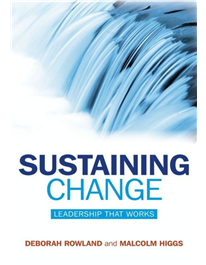I just finished reading Sustaining Change: Leadership that Works by Deborah Rowland and Malcolm Higgs. I appreciate my colleague Dr. Barrett Mosbacker loaning it to me. I believe that the new lending program through Amazon Kindle will allow me to grow as a leader by reading books that I might not otherwise have picked up on my own.
Sustaining Change is written for leaders who truly have a desire to lead an organization through a necessary change. This is also particularly for leaders that desire to create a culture that is open to change as needed in order to run hard after the vision of the organization. This book has a lot of statistics that are interesting to consider. I appreciate the way the authors addressed different styles of leadership and how to take that into consideration as you evaluate the steps for change in your organization.
Below I have listed some notes that I highlighted while reading…
- A key finding emerged from the early days of our inquiry: leaders who see change as an ongoing process that occurs naturally around them all the time, when compared to leaders who see change as a one off event, a think to be managed, or a program with a beginning and end, were more likely to be successful in realizing the desired change outcomes.
- When we dug deeper into the findings, what struck us was that it seemed to matter how leaders were leading the change – in fact what leaders did was the single biggest reason explaining why some changes we studied were successful, and others were not.
- It has been said that ′we move in the direction of the questions we ask′ (Margaret Wheatley).
- Just by trying to change how other people function, without acknowledging, inquiring into, and trying to adjust the fundamental reason why they function that way in the first place, will only produce patchy and half hearted results. It will work against the grain and fail to harness the creative energy within people to move in to a different future.
- The predominant assumption behind the Directive change approach is, ′I can manage change′.
- The predominant assumption behind the Self Assembly change approach is ′launch enough initiatives and something will stick′.
- The predominant assumption behind this change approach is, ′trust your people to solve things with you′.
- The predominant assumption behind the Emergent change approach is, ′I can only create the conditions for change to happen′.
- Adopting a change approach that assumes complexity is more likely to bring success than the simplistic approaches.
- The Master change approach is strongly related to success in ongoing, longer term change.
- If leaders do not reflect on and pay attention to their own leadership behaviour they could reduce their chances of successfully implementing high magnitude change by a half.
- Leadership behaviours that centre on the position, role and power of the leader and their abilities – in other words the Shaping leadership factor – do not appear to be related to successful change. Indeed, such behaviours are related to change failure.
- Framing leadership alone accounts for over half the reason why high magnitude change succeeds.
- In short term change Framing leadership is the most effective leadership practice.
- In longer term change, and where the change is ongoing, Creating Capacity leadership is related to success.
- The successful leadership of change seemed to be about leading in the moment. The power of the present was all important.
- Connects with others at an emotional level, embodies the future intent of the organization.
- Tunes into the day to day reality of the organisation, sees themes and patterns at local level that connect to a wider story, and from this creates a collective story for the whole organization.
- Uses the collective story to set the context for the change and weaves the story into the life of the organisation so that every decision and action makes sense.
- Stays constant when the going gets tough; does not withdraw from the difficulty; keeps people′s ′hands in the fire′.
- Makes it safe to say risky things and have the ′hard to have′ conversations through empathy and high quality dialogue skills.
- Creates alignment at the top and builds networks of relationships that stay in tune with the system and can channel the change.
- Understands what is happening in the moment and breaks established patterns and structures in ways that create movement in the ′here and now′
- Powerfully inquires into ripe systemic issues to enable deep change to happen.
- Extremely self aware and conscious of how to use their presence in a change process.
- Able to work in the moment, staying attentive, expectant, and available to work with what arises.
- Authenticity springs from your intention – and this can also affect your impact on others.
